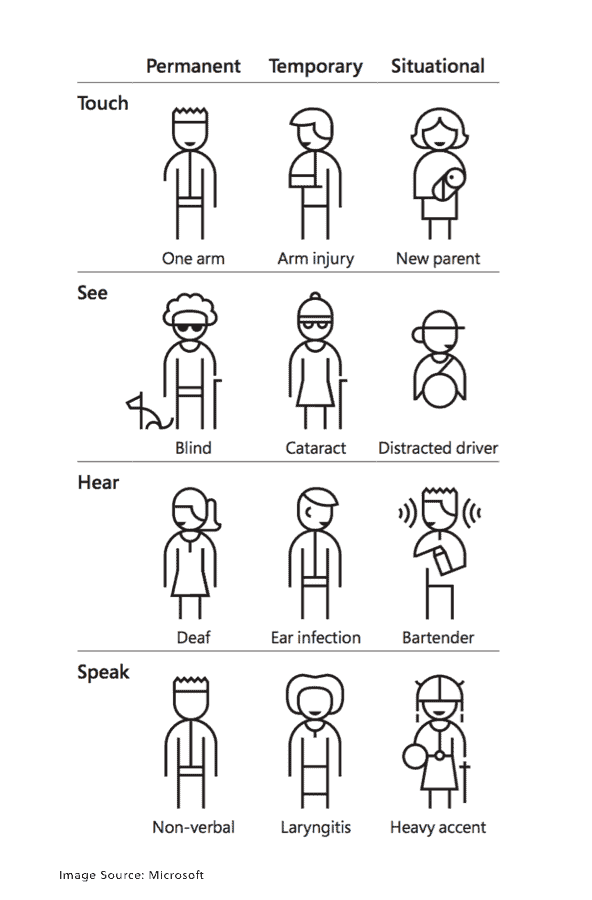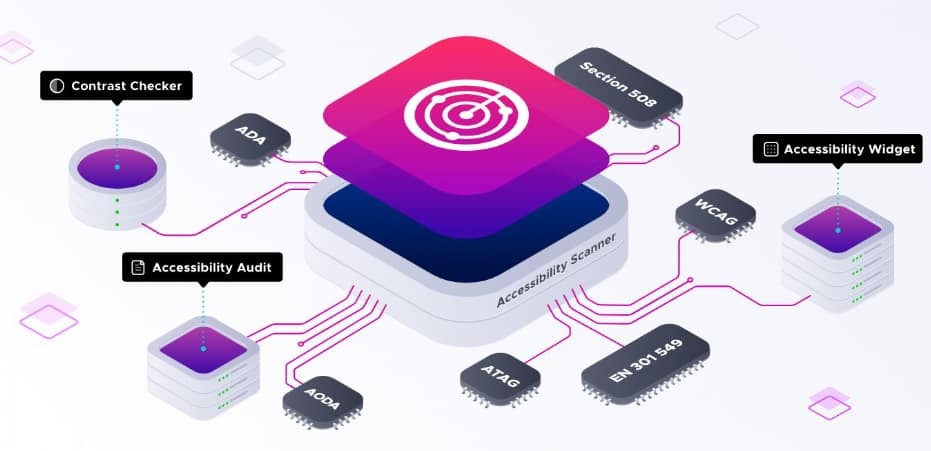When we think of being accessible we think about how physical stores have ramps and elevators or disabled parking and wheelchair access. But, this kind of accessibility is only one small part of accessibility.
Accessibility isn’t confined to physical spaces. It’s also an essential aspect of the digital space. If your website isn’t compliant with the rules of online accessibility, you’re at risk of being sued.
If you have a website, you can be sued for not being accessible to people with disabilities. Corporations like Domino’s Pizza have been sued for failing to have a fully accessible business, as well as smaller mom and pop type stores. Everybody who owns a website has the responsibility to be accessible: The Americans with Disabilities Act (ADA) states that everybody should have equal rights to access online information and services.
This isn’t just for large businesses. It includes everybody.
Whether you’re a small landscaping business, a pool and spa company, or even a one-person show – if your website isn’t up to standard, you’ll be sued just as quickly as the bigger brands out there. Some companies have even been put out of business because of accessibility lawsuits.
Now, we’re not here to scare you. We’re here to help you. So today, we’ll explain everything you need to know about making your website as accessible as possible to people with disabilities.

What is the ADA?
The Americans with Disabilities Act (ADA) was introduced and signed into law on July 26, 1990, by George W. Bush. The ADA prohibits discrimination against people with disabilities.
Now, websites aren’t strictly mentioned in the ADA law – it was introduced over 30 years ago. But, it does prohibit companies from creating communication barriers that restrict access to their products or services from people with disabilities. This includes a website that isn’t accessible.
How does the ADA affect websites?
People use the internet every day for all kinds of things. After COVID-19, more people felt the importance of getting their businesses online and using the internet for shopping and communication.
The internet can be used for almost every aspect of your daily life. Everything is online now, from banking, shopping, and taxes, to consuming media and chatting with friends.
So, imagine if you were trying to order groceries to your home, but then the website you were using suddenly stopped working. You needed to do your weekly shopping for your family, and now you can’t. It’d be incredibly frustrating, right? You wouldn’t be able to complete this essential task.
The ADA is designed to prevent things like this. People with disabilities have to use assistive devices like screen readers, voiceover software, and Braille output devices to read and understand websites. If the website they are using doesn’t work with their device, then they won’t be able to use the website.
If they can’t use your website, they could suit up and hire a lawyer, which could cost you a lot of money if they win their court case against you.
Web Accessibility is not only for people with disabilities but for all of us who are thankful that there are no barriers in using our abilities.
– Remberto Esposa, Jr.
How do people with disabilities use the internet differently?
Assistive technology is a lot more common than you think. For example, glasses could be considered assistive technology. Glasses and contact lenses help people see clearer, but some visual impairments require more than just glasses.
For example, color blindness or legal blindness requires a screen reader. A screen reader will scan the website and read out what’s on the screen to the user, allowing access to the content despite their disability.
Another example of how people with disabilities use assistive technology is closed captioning or a downloadable transcription of a site. This helps people who are deaf or hard of hearing gain access to any audio on a website.
Physical disabilities are also catered to online. Instead of a keyboard, some people with physical disabilities use equipment like head pointers, eye movement devices, or text to speech software.
These are only a few examples of assistive technology, and your website has to be able to work with all of them. If you want all your customers to have access to your website, you need to make sure it will work with these technologies.
The best way to make sure your website is fully accessible is to follow the Web Content Accessibility Guidelines (WCAG).
What are the Web Content Accessibility Guidelines?
The Web Content Accessibility Guidelines (WCAG) were published in 2008 by the W3C Web Accessibility Initiative.
These guidelines provide the criteria you need to follow to ensure your website is accessible. To reach the basic requirements, you have to hit level AA.
The following needs to be accessible for you to hit level AA:
- Text content
- Videos
- Images
- Buttons
- Hyperlinks
- PDFs
- Items or services for sale
- Documents
- Forms
- Any other types of content you offer
How does accessibility impact SEO?
Did you know that some of the basic SEO principles like headings and alt text for images are necessary for making your website accessible?
So not only do these sections help you make your user experience better and enhance your visibility on search engines, but it also helps people with disabilities access your website.
A lot of the fundamentals of SEO and accessibility overlap, including
- Site and page structure
- Video captions
- Alt text for images
- Readability of content
The structure of your page, for example, makes it easy for search engines to scan your page in the same way that a screen reader will scan your text and read it out to people who are visually impaired. So it’s essential to have clear sections on your website with relevant heading titles.
Poor page structure also makes it near impossible for screen readers to distinguish between sections. This makes it difficult for people who use screen readers to access websites to determine what section they’re reading. Sometimes screen readers will even jump to different parts of the website, which is confusing for users.
Can accessibility negatively affect SEO?
If you implement accessibility standards correctly, you’ll actually be able to improve your SEO. When you build your website, you’re making it for people, not computers. So, accessibility and SEO go hand in hand and work incredibly well together.
Accessibility won’t have a negative effect on your SEO, and it can actually help improve it.
As long as you don’t stuff keywords into alt tags, you’ll find that your website will rank pretty well when completely optimized for accessibility. Keyword stuffing alt text isn’t very accessible either as it can confuse people using screen readers – plus Google doesn’t like it.
Is accessibility good for SEO?
Absolutely. If you put effort into achieving complete ADA compliance, then Google will take notice of your website. An accessible site is a user-friendly site, and Google loves to see every user interacting pleasantly with websites.
If you keep SEO and accessibility a top priority, you’ll see your website rank higher on the search engine results page in no time at all, and you’ll have better engagement!
Does my website need to be ADA compliant?
People with disabilities account for one in five website users, so if you’re not accessible, you’re already losing out on 20% of your customer base. That’s a lot of money you’re losing out on simply for not having an accessible website.
If your website doesn’t meet the standard requirements, you could also get sued. If we include fines, lawsuit settlement payout, and attorney fees – that’s a lot of money.
Not being accessible can be potentially very expensive. Some companies have even gone out of business on the lawsuit payout alone.
The maximum penalty for the first violation that the Department of Justice imposes is $75,000. For subsequent offenses, it’s $150,000, which is a lot of cash for a small landscaping business to have to payout.
This is why it’s so essential to be ADA compliant. But how do you become ADA compliant? What’s involved in making an ADA-compliant website?

How do I make my site ADA compliant?
Meeting the current website accessibility standards is necessary for your survival online as a business. You should consider optimizing the following first to get your company over the minimum threshold:
- Make all interactive elements accessible by allowing them to be activated using a keyboard
- Make sure the content on your website works while zoomed in
- Ensure your website is mobile responsive
- Adapt content that is only accessed by sight, sound, or color. For example, include alt text on images and closed captions on video content
- Don’t use auto-playing audio
- Ensure all of your text can be scanned and your website’s sections are distinguishable so screen readers can scan them
Once you’ve updated your website, remember that accessibility doesn’t end there. Like SEO, you have to update your website to meet new rules and regulations continuously. Plus, if you actively update your website with fresh content, make sure you have a team ready and educated to put new content up in an accessible way.
We know all of this can be a bit confusing, and accessibility is an awkward path to travel down, but with the right help, you can ensure your website is accessible to everybody.
Start by using the Accessibility Inspector below to check for any violations.
If you think your website needs to be updated to be accessible to people with disabilities, then now is the time to make those changes. Getting help from an expert will allow you to ensure that your website is accessible.
We’re specialists in helping outdoor contractors excel online by building them unique websites and helping them create the perfect branding for their company. Our team will also help you make sure that your website is accessible so you can avoid any lawsuits and get more customers interacting with your website.
We have partnered with an amazing tech company that has created a complete accessibility solution that makes your website ADA compliant and digitally inclusive!
Click on the accessibility icon in the bottom corner to try it out!
Get in touch with our team today if you want to build a more accessible website for your business.




